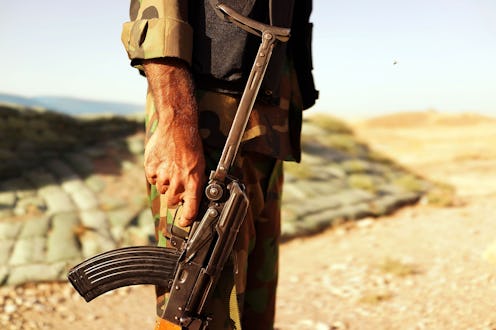News
Remembering Steven Sotloff's Life, Not His Death
The news everybody has feared since the execution of American journalist James Foley has finally come. ISIS has apparently executed another American journalist, Steven Sotloff, the man specifically threatened at the end of the Foley video. On Tuesday morning, reports began to swirl that a nearly identical video of Sotloff being beheaded was circulating on jihadist websites, according to SITE Intelligence Group. So, here's our plea: Don't watch ISIS kill Steven Sotloff. Remember his life, instead.
The point of making such a graphic execution video is to generate fear, despair and panic, and to attract attention to ISIS and their cause. As such, there's probably no better way to honor Sotloff's memory than to click away from that video anywhere and everywhere you find it.
Your time would be better spent, frankly, by reviewing the work that Sotloff risked his life — and ultimately gave his life — to produce. Sotloff was a freelance journalist who contributed numerous reports to Time, and was reporting from the war-torn city of Aleppo, Syria, when he disappeared in 2013.
Sotloff was 31 years old, and had reported from a wide swath of conflict-heavy places across the Middle East, in Syria as well as Libya, Turkey and Bahrain. His reporting in Syria in particular was notably brave and selfless, and not just because of the fate that ultimately befell him — the Syrian civil war has been raging since 2011, and dozens upon dozens of journalists have lost their lives trying to cover the conflict.
In 2012, he was front-and-center on the ground in Libya, and filed a number of reports for Time in the aftermath of the attack of the American consulate in Benghazi. In particular, he covered the response of moderate Libyans to the attacks (which killed U.S. Ambassador Chris Stevens, along with a U.S. officer and two CIA defense contractors), documenting the efforts of local leaders to combat and condemn the radical violence.
It's the kind of story — reflecting both the moderating influences in Libyan society and the radical ones, not painting one group as a whole — that too often goes overlooked or unwritten.
Friday’s march grew out of a civil society campaign to highlight a widespread condemnation of the attack that killed American envoy Chris Stevens and three others 10 days ago. “The Friday to Save Benghazi,” was advertised on television, radio and the internet. “We want to save Benghazi from the violence and get rid of the militias,”says protest organizer Muhammad Bujan.
Sotloff departed from Libya in late 2012 bound for Syria, where he would contribute a number of reports for Foreign Policy, detailing the everyday brutalities of the war between Bashar al-Assad, and the fractured, various rebel forces throughout the country. His attention to the plights of oppressed people shines through brightly in his article from Dec. 24, 2012, titled "From Bread Lines to Front Lines." Sotloff examined how the civil war's catastrophic effects on infrastructure had thrown so many Syrians, even non-combatant civilians, into catastrophe and hunger.
Jamila Hijali initially shied away when I approached her in one of the many lines outside Aleppo's bread factories and bakeries. But after a moment she motioned me over to vent her frustrations. "We are tired of the revolution because before women never stood in line for bread like this," the 39-year-old widow with six children complained. "But now it is my primary occupation in life. Bread line. Sleep. Bread line. Sleep."
The 21-month long Syrian revolution is taking its toll on residents of the country's largest city. With everything from medicine to firewood in scarce supply, and with winter bringing temperatures down to near freezing, people here are struggling to cope with a war they just hope will end.
Sotloff's demonstrated interest in telling the stories of suffering populations was one of the things his mother, Shirley Sotloff, cited in her emotional plea to ISIS to set him free last week.
As hard as it was to watch at the time, it's much harder now. Shirley addressed her message directly to Abu Bakr al-Baghdadi, ISIS' leader and self-proclaimed caliph of the Islamic State, appealing to Steven's interest in the oppression of Muslims, his role as an innocent journalist, and her natural love and desire to see him home safe.
But some U.S. officials, according to The Wall Street Journal, now believe that Sotloff may have been dead before her appeal even went public. The suspicion is that ISIS may have executed Sotloff immediately after killing Foley, but merely sat on the footage for weeks to intensify its effect — they also suspect that the British man threatened following Sotloff's killing, David Haines, may already have been killed. It's worth stressing that these are anonymous reports, however, and there's no way to be certain about something so devastating just yet.
Rest assured, you'll be hearing more about Sotloff's life and career in the coming days, though also a lot about his death, too. And that makes sense, because how he died is important — it could theoretically impact foreign policy and possible military action.
But in spite of all that, whenever and wherever possible, let's try to make sure ISIS doesn't win that final victory — making that photo of him, orange-jumpsuited and on his knees, the enduring image of his life. Instead, try passing around some images of him living life.
Images: The New York Times/YouTube
